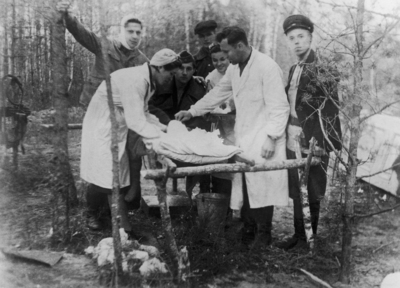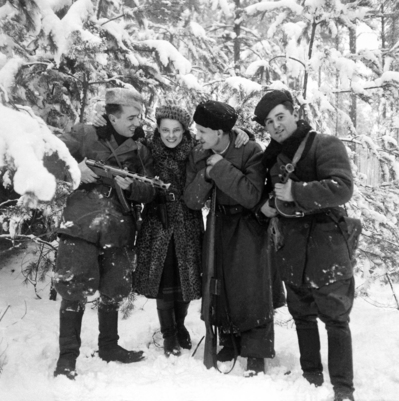Photo exhibit offers rare look at hidden heroism in World War II

“Shish Detachment Field Operating Table (Forests around Pinsk, 1943)”
25 black-and-white photographs taken in the early 1940s by Polish partisan Faye Schulman, “Pictures of Resistance” is an astoundingly brave portrait in the face of seemingly insurmountable odds. Schulman’s work—the only photographs to emerge from this underreported theater of World War II—is graphic and confessional, as well as a firsthand look at what life was like in Eastern Europe during this mid-20th century period of infamous barbarity.
The only survivor of a large family in Lenin, Poland (in today’s Belarus just north of the Pripet River), Schulman (only in her early 20s) was one of just 26 survivors in that town’s Jewish ghetto of 1,800 people because of her skill with cameras. She’d learned the rudiments of photographic development as a young girl from her older brother and she was required to develop the negatives of photographs taken during the destruction of her hometown.
Knowing her survival was at stake after seeing the evidence of this genocide, Schulman escaped with duplicates of her work during a partisan raid of escaped Soviet Army prisoners of war. Joining the Shish detachment of the Molotov Brigade, Pinsk formation, as a nurse, Shulman doubled as one of the few partisan photographers in that part of Eastern Europe.
As Shulman told “Reflections: The Newsletter of the William Breman Jewish Heritage and Holocaust Museum” in 2010, “The main part of being a partisan was not the killing but keeping the wounded alive, bringing them back to life so they could continue fighting to bring the war to an end.”
During the years of 1942-44, Schulman took hundreds of photographs using a Doppel-Anastigmat folding camera with Zeiss Icon lens while on missions. Repeatedly burying her equipment when it was not in use, Schulman developed photographs under blankets, making sun prints during the day.

“Faye with Old Friends (Forest near Lenin, Winter, 1944)”
This observation is remarkably modest considering the danger involved in this work. Schulman’s “memories” provide a firsthand glimpse of the face of bravery in the midst of tribulation. Instead of Hollywood bravado, these photographs instead give us a sense of quiet gallantry—and in many remarkable instances, an equally powerful glimpse of unyielding solidarity—instead of scenes that might have been an unrelenting sorrow.
Some of these photos—for example, “Faye with Old Friends (Forest near Lenin; Winter 1944)”—manage to capture a glimpse of intrepid pluck. There is a sense of cagey casualness in this work that makes it doubly astonishing. The tension is palpable but so is the sprightly joy of being alive. And this would make total sense given that the larger numbers of partisan fighters in Eastern Europe were young adults in their late teens and 20s.
On the other hand, Shulman also sought to record those others who lived among her in these hidden sanctuaries. Her “Partisans in the Forest (Forest near Lenin, 1943)” is really no more than a family portrait, albeit under exceedingly dire circumstances. And the somber ecumenical “Partisan Burial (Forest near Pinsk, Early 1944)” shows mingled resolution and sorrow among a group of refugees as they witness the burial of two Jews and two gentiles killed in a partisan activity.
Above all else there are (despite Shulman’s reservation) some dynamic actions shots in the exhibit. Her “Shish Detachment Field Operating Table (Forest around Pinsk, 1943) features the heroics of a makeshift medical team at work. And the “Molotov Brigade Partisan Leaders (Forest around Pinsk, End of 1943—early 1944)” is a candid photograph of a resolute collective shrewdness.
“”I want people to know there was resistance,” says Schulman of her effort. “I was a photographer. I have pictures. I have proof.” No better words could be said of Schulman’s indomitable spirit. Her proof is indeed in these photographs. And these photographs are the testimony of a lifetime.
“Pictures of Resistance: The Wartime Photographs of Faye Schulman” will continue through Nov. 27 at the University of Michigan Harlan Hatcher Graduate Library Gallery, Room 100, 913 S. University St. Exhibit hours are 8 a.m.-7 p.m. Monday; 8 a.m.-2 p.m., Tuesday-Thursday; 8 a.m.-7 p.m. Friday; 10 a.m.-6 p.m. Saturday; and 1-5 p.m. Sunday. For information, call 734-764-0400.


Comments
EyeHeartA2
Tue, Oct 25, 2011 : 12:30 p.m.
A fascinating story. Incredible work. Thank you for this information.